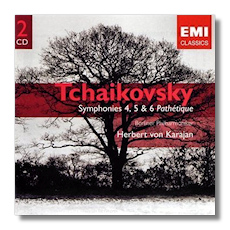
The Internet's Premier Classical Music Source
Related Links
- Tchaikovsky Reviews
- Latest Reviews
- More Reviews
-
By Composer
-
Collections
DVD & Blu-ray
Books
Concert Reviews
Articles/Interviews
Software
Audio
Search Amazon
Recommended Links
Site News
 CD Review
CD Review
Piotr Ilyitch Tchaikovsky

- Symphony #4 in F minor, Op. 36
- Symphony #5 in E minor, Op. 64
- Symphony #6 in B minor "Pathétique", Op. 74
Berlin Philharmonic Orchestra/Herbert von Karajan
EMI Classics 381798-2 ADD 2CDs 73:07, 64:59
Herbert von Karajan recorded Tchaikovsky's last three symphonies umpteen times, starting in the pre-stereo era, and there were new recordings not long before his death, too. These three symphonies were recorded over less than a week in September 1971, and so they fit somewhere in the middle of Karajan's discography. His EMI recordings have been reissued with less regularity than those he made for Deutsche Grammophon. In fact, I am wondering if this is the first reissue that these recordings have received: the year for these digital remasterings is 2007.
In any case, these are interesting but far from perfect recordings. One can understand why they might have been a lower priority for EMI. The best of them is Fourth. I don't think Karajan recorded a better stereo version than this one. It is exciting and emotional, but never self-indulgent, and the playing of the Berlin Philharmonic is very much up to par. It alone is worth the price of these two CDs. (And the price is low, because this is a mid-priced reissue in EMI's two-for-one "Gemini" series.)
The Fifth and Sixth are more problematic. The recording venue was the Jesus-Christus-Kirche in Berlin, and the producer was Michel Glotz. For a Karajan recording, the engineering is surprisingly "churchy," to the point of being overly resonant. Brass fanfares take several seconds to die completely away, and the sound becomes soupy during climaxes because of all the sonic information bouncing off the church's interior walls. The trumpets sound thin and pinched. This might be a problem with musicianship, but I think it is more likely to be a problem with how the trumpets were recorded. Suffice it to say that the Berlin Philharmonic doesn't sound like itself here. Odd, because these problems seem less prominent in the Fourth Symphony.
There are weird things happening on the podium too. Karajan encourages portamento-laden playing from the strings, particularly in the slow movements. "License" certainly is taken in the Fifth's Andante cantabile, con alcuna licenza – in fact, one might even suggest that the string playing is licentious! Yet there are beautiful things too. At the start of finale of the "Pathétique," the strings are so refined, it makes one wonder if the players are touching their instruments at all; the music seems to be coming out of the ether. It's haunting, and quite appropriate. In between the passages of insight and excitement, there are moments that are preciously self-regarding. These recordings provide ammunition for Karajan's detractors, as well as for his fans.
A booklet note by David Nice (also newly penned) adds nothing to our knowledge of the music, although they are poetic. Nice refers to Karajan's performance of the Fifth as "beaten-bronze," which strikes me as a pretty good analogy.
Copyright © 2007, Raymond Tuttle




















